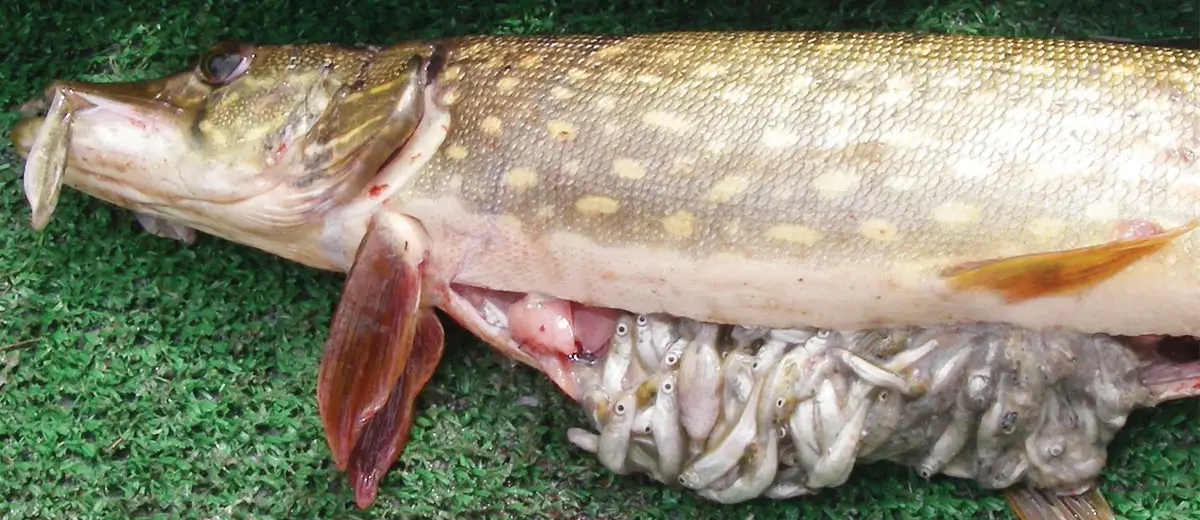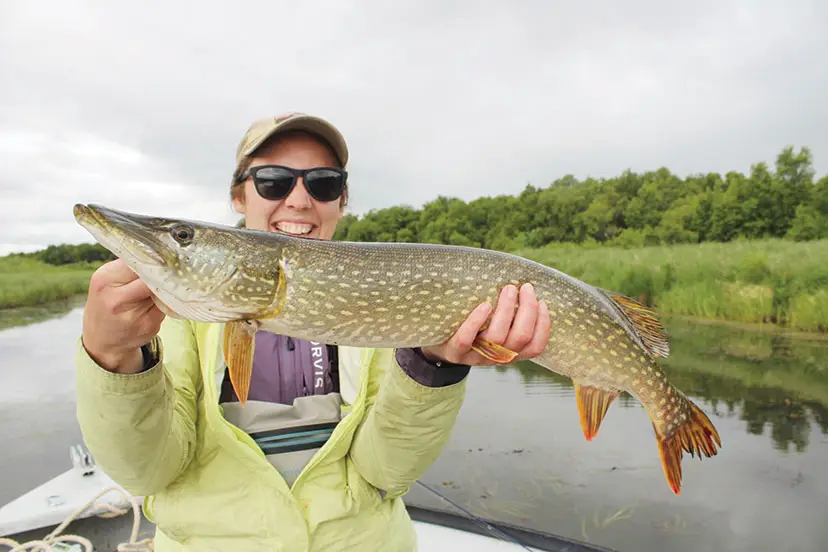Alaska pike are a thrilling sport fish—and a serious ecological threat in the wrong waters. While native in parts of the state, illegally introduced northern pike have devastated salmon and trout populations in others, forcing aggressive management efforts.

Pike love to feed on juvenile salmon and trout. © Alaska Department of Fish and Game
There, in the shallows, just off the fringes of a weed bed, a dark shape looms, its substantial girth that of a good-sized submerged tree trunk. I’m careful, as careful as one can be casting an enormous articulated leech, to lay my fly just beyond it, hoping not to spook this hulking monster.
Sure enough, as I begin to strip my line it turns and in a massive arc sweeps decisively toward me, picking up speed to intercept my offering. I strip faster and the fly, now just inches below the surface, is clearly visible, as is the immense shadow of this fish and its wake as it closes in for the kill. Not five feet from the boat I see its impressive maw open, as if in slow motion, sucking in the fly. My line goes tight, frantically peeling from the reel as the fish heads into deeper water, and a nearly ten-minute battle royale begins. This is pike fishing.
The thrill of pike fishing is something that had been far from my thoughts for quite a while. That’s probably because I’ve spent the better part of the past four decades in southcentral Alaska, focusing most of my energy on other species. In that time my focus, my passion, and love for fishing has turned almost exclusively to rainbow trout and salmon. Here on the Kenai Peninsula, where northern pike are an invasive species, I had come to think of them in a different light, a negative light, and for good reason.
The Pike Problem
Anyone who knows pike understands they are apex predators, capable under the right circumstances of laying waste to other populations of fish, including salmonids. That was the fear here on the Kenai Peninsula, where pike were originally illegally introduced, and why a massive, 18-year eradication effort was undertaken. Currently and thankfully, there are no known pockets of pike on the Kenai Peninsula. Kristine Dunker, the Alaska Department of Fish and Game (ADF&G) biologist who coordinates the department’s invasive pike program, says biologists are cautiously optimistic they can keep it that way, though her caution is tempered by recent scientific evidence showing that a small number of pike have moved through the marine waters of Cook Inlet, subsequently populating a remote freshwater lake.

The range of native pike is shown in blue. The range of invasive pike is shown in red. Map courtesy of Alaska Department of Fish and Game.
Marine Movement and New Discoveries
By studying the chemical fingerprint of the otoliths, the tiny ear bones that record much of a fish’s life history, scientists were able to confirm that pike found in Vogel Lake, on the Kenai National Wildlife Refuge and connected to the inlet by a small stream, had indeed spent time in the marine environment. This corroborates anecdotal reports from Cook Inlet commercial fishers who have occasionally reported finding them in their nets. This is a significant discovery because previously it was believed that large natural barriers, such as the saltwater of Cook Inlet, would prevent populations of invasive pike from spreading. This new evidence challenges long-held beliefs about how these invasive fish spread and has forced scientists to reconsider the strategies they use for controlling their expansion.
Adaptability and Ongoing Risk
We know that northern pike are extremely adaptable and while they do not have the capacity to survive for very long in saltwater, it is now clear that at certain times, conditions in Cook Inlet are favorable for their survival. This appears to be especially true in spring and summer when meltwater from snow and ice is flowing. It is likely during these times that pike in Vogel Lake, as well as pike recently found in Westchester Lagoon and Campbell Lake in Anchorage, migrated from the Matanuska-Susitna Valley, where pike have also been illegally introduced.
“Unfortunately,” reports Dunker, “the infestation in the Mat-Su region may be too widespread to eradicate.” It’s believed that invasive northern pike may inhabit as many as 150 waterbodies in the vicinity of Anchorage as well as several in southcentral Alaska, including the Knik Arm drainage, the Susitna drainage, and even some western Cook Inlet drainages. At this point efforts to control pike have mostly turned toward triage. Where are the most sensitive areas? Those are the places, Dunker says, that ADF&G will prioritize, concentrating their efforts to try to limit the spread of non-native pike.

A pike caught in western Alaska. © Meghan Barker

A pike caught in interior Alaska. © Matt Albert
Invasive versus Native Pike
Northern pike are native to much of the state. They are a fixture in the freshwater systems north of the Alaska Range and in western Alaska. How is it that they can co-exist with other species there? Part of the equation is thousands of years of evolution, where populations have adapted to one another. The other, explains Dunker, is habitat segregation. In western Alaska, for instance, you have deep cold-water lakes and fast-flowing streams, ideal for salmon, but not pike; and you have slow-moving, weedy areas, that are ideal for pike, but not necessarily salmon.
You might not have these factors in a place where non-native pike are introduced. Combine that with pike’s natural inclination to move, along with natural occurrences, such as flooding events, and pike can easily spread into prime salmon and trout water. And as a top predator it doesn’t take long for pike to totally devastate these inherently and economically important fisheries.
Fishing for Alaska Pike
Pike fishing is a heck of a lot of fun on a fly rod. On my latest adventure, I went after them with an 8-weight rod. I fished on the surface with a variety of large dry flies, mouse, and frog patterns, as well as a variety of attractor patterns that likely did not resemble anything in the natural world yet attracted the attention of these voracious and indiscriminate feeders.
I also employed an intermediate sink-tip line, fished with a short leader, and a variety of large leech and streamer patterns. My favorite, or should I say the pike’s favorite on one of my recent pike fishing trips, was a dark purple-and-black articulated leech.
In southcentral Alaska, and other areas where they are not native, pike must be removed from the water and killed. Any pike caught from a waterbody with an unknown population should be immediately reported to the ADF&G’s invasive species hotline: 1-877-INVASIV (1-877-468-2748). If you are unsure of known populations of invasive pike, visit ADF&G.
Regulations differ where northern pike occur naturally, such as Minto Flats in interior Alaska and the Wood River drainage in Bristol Bay. There are often size limitations around keeping pike in these areas, so be sure to check the regs before you go.

A selection of pike flies tied by the author. © Dave Atcheson
Pike fishing is a great sport. In the right locations, pike are an important game fish. In the wrong locations, they wreak havoc on our coveted trout and salmon populations. We must do our part to stop their spread in areas where they don’t belong. Next time you’re fishing in the Mat-Su, target pike and help remove some invasives. It’ll be one of the most fun good deeds you’ll ever do! (Editor’s note: Though they are bony and there’s a trick to filleting them, pike are delicious, with flaky white meat.)
Trout Unlimited’s mission is to protect, reconnect and restore North America’s cold-water fisheries and their watersheds. Learn about our work in Alaska at prioritywaters.tu.org/alaska.
About the Author
Dave Atcheson is Special Projects Assistant for Trout Unlimited Alaska. He is also the author of several books, including Hidden Alaska, Dead Reckoning, and Canoeing Yaghanen. For more info: daveatcheson.com.
For more conservation and fish habitat restoration reading, check out Fish Alaska’s Conservation Blog for more.


